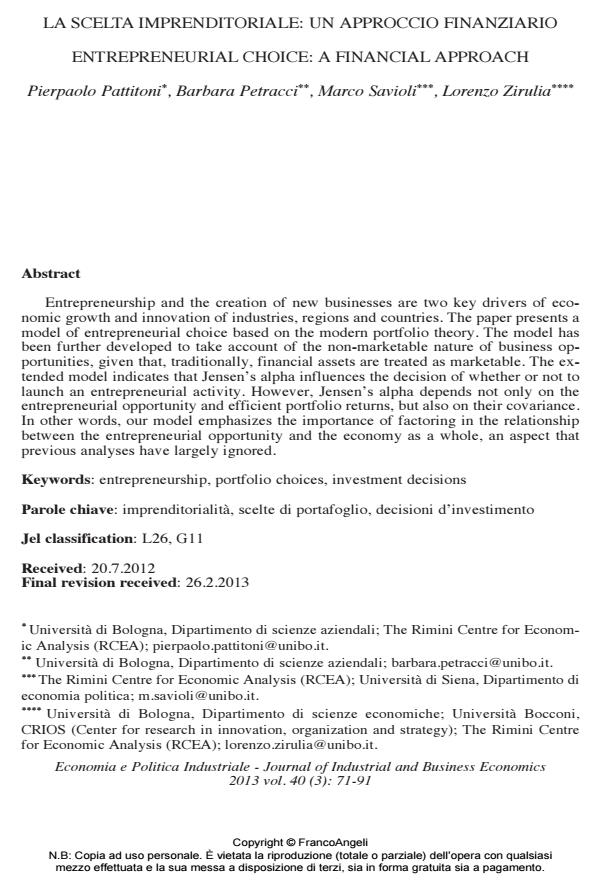Entrepreneurial choice: a financial approach
Journal title ECONOMIA E POLITICA INDUSTRIALE
Author/s Pierpaolo Pattitoni, Barbara Petracci, Marco Savioli, Lorenza Zirulia
Publishing Year 2013 Issue 2013/3
Language Italian Pages 21 P. 71-91 File size 290 KB
DOI 10.3280/POLI2013-003003
DOI is like a bar code for intellectual property: to have more infomation
click here
Below, you can see the article first page
If you want to buy this article in PDF format, you can do it, following the instructions to buy download credits

FrancoAngeli is member of Publishers International Linking Association, Inc (PILA), a not-for-profit association which run the CrossRef service enabling links to and from online scholarly content.
Entrepreneurship and the creation of new businesses are two key drivers of economic growth and innovation of industries, regions and countries. The paper presents a model of entrepreneurial choice based on the modern portfolio theory. The model has been further developed to take account of the non-marketable nature of business opportunities, given that, traditionally, financial assets are treated as marketable. The extended model indicates that Jensen’s alpha influences the decision of whether or not to launch an entrepreneurial activity. However, Jensen’s alpha depends not only on the entrepreneurial opportunity and efficient portfolio returns, but also on their covariance. In other words, our model emphasizes the importance of factoring in the relationship between the entrepreneurial opportunity and the economy as a whole, an aspect that previous analyses have largely ignored.
Keywords: Entrepreneurship, portfolio choices, investment decisions
Jel codes: L26, G11
- Strategic orientation of hotels: Evidence from a contingent approach Manuela Presutti, Marco Savioli, Vincenza Odorici, in Tourism Economics /2020 pp.1212
DOI: 10.1177/1354816619868886 - Determinants of profitability in the EU-15 area Pierpaolo Pattitoni, Barbara Petracci, Massimo Spisni, in Applied Financial Economics /2014 pp.763
DOI: 10.1080/09603107.2014.904488 - Do overconfident and over‐optimistic entrepreneurs invest too much in their companies? Theory and evidence from Italian SMEs Enrico Maria Cervellati, Pierpaolo Pattitoni, Marco Savioli, in Strategic Entrepreneurship Journal /2022 pp.769
DOI: 10.1002/sej.1421
Pierpaolo Pattitoni, Barbara Petracci, Marco Savioli, Lorenza Zirulia, La scelta imprenditoriale: un approccio finanziario in "ECONOMIA E POLITICA INDUSTRIALE " 3/2013, pp 71-91, DOI: 10.3280/POLI2013-003003